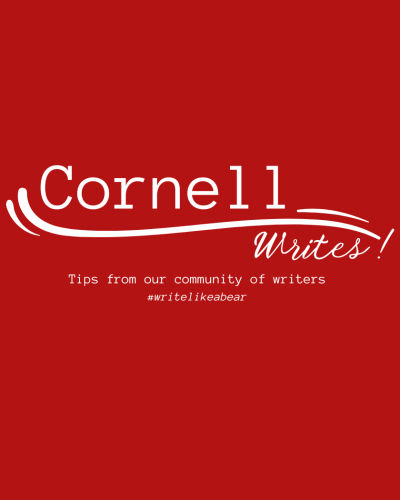Cornell Writes! Tips from our community of writers is a digital newsletter sponsored by the Knight Institute for Writing in the Disciplines and the Cornell University Graduate School.
Each week, a member of our writing community – a Graduate Writing Service, English Language Support Office, or Cornell Writing Centers tutor; a writing specialist from the Knight Institute; a writing instructor from our First-Year Writing Seminars or Writing in the Majors programs; maybe YOU – will share a writing strategy from their own writer’s toolkit. #writelikeabear
Contact Tracy Hamler Carrick with questions and ideas.
Meet Tracy Carrick
Hello Cornell writers! My name is Tracy Carrick. I am a teacher, tutor, and director of the Knight Institute’s Writing Workshop and Graduate Writing Service. I am also a writer and editor. This week, I am responding to student writing and designing lesson plans.
Here is this week’s Writing Tip!
If you have ever met with me to workshop a draft, you know that I like to look for repetition. Do you repeat syntactic structures, phrases, or words? Do you have typical ways of opening or closing paragraphs or working with source or visual materials? Are these patterns intentional, desirable, revealing? What are their origins? To what extent do they enable or hinder your writing process, clarify or cloud your readers’ experience?
I enjoy doing this kind of collaborative work with writers because the process can unsettle the way they see themselves. Sometimes, I playfully refer to these repeating patterns as signature moves, a strategy that can further solidify our identities as writers – I have signature moves! I have a writing style! What delightful moments! (Stay tuned for a post on metaphor, one of my favorite signature moves.)
But not all repeated moves, you’ll rightly note, should be elevated to the status of signature moves. Sometimes, we should push against them and leverage them as disruptive tools that can signal a text’s weakest moments.
One of the most common repetitions I encounter when reading academic writing – in all disciplines and from writers at all levels – is the frequent use of conjunctive adverbs, otherwise known as transition words. You know them: however, therefore, and thus, the most persistent among them. (The word “this” comes in a close second. See my previous Cornell Writes! post, “Let’s Talk about This!”)
When reading or being read to, I may quietly highlight one “however” or “therefore” or “thus” after another…and another…and another. At the end of the paragraph or page, when we pause to comment or discuss, many writers straighten up and claim the repetition as a signature move (That’s my style!) or as an expected convention or necessary feature or signature move of academic writing (That’s academic style!).
Nope. Not exactly. While it is true that conjunctive adverbs are commonly used in academic (and other) writing communities to signal not only a transition to a new idea but also the nature of the shift (contrastive, comparative, causal, sequential), they can undermine a writer’s authority and clarity more than we may realize. Many writers, I have found, overuse these words. A lot. It is not unusual for me to see at least one, if not several in every single paragraph. I recently read a draft in which “however” appeared 5 times in the first paragraph alone.
Sometimes writers overuse conjunctive adverbs because they are picking up and learning to use words that are, to be fair, quite common in academic writing. This process, repeating what you hear and read, is certainly an important part of the initiation and acculturation process. Further, since conjunctive adverbs can function as heuristic devices that push writers toward critical intellectual moves, writers might also be using these words in order to more deeply internalize academic habits of mind. All of this is to say that using conjunctive adverbs may be important to our intellectual growth. Knowing their developmental significance could help us reach more quickly, perhaps, toward a more confident and authentic voice. Or maybe the knowing simply gives us kind permission to be patient with ourselves.
Writers might also overwork conjunctive adverbs to mask unfinished or unclear thinking. It’s true – a strategically-placed “however” or “therefore” can tenuously hold together untidy ideas (See Cornell Writes! post “How to Flow!”). When a writer and I identify this pattern, especially when several of these attention-drawing words are highly concentrated in a particular paragraph or section of a draft, it usually means that the writer needs to do some more thinking and writing. I do not see such observations as bad things (though the writer chasing a tight deadline might disagree!). Quite the opposite. Conjunctive adverbs can lead writers swiftly to the passages that need attention, places that reveal opportunities to skillfully maneuver their words with more power and grace. Follow these steps on a very important passage and see what you learn about your draft and even yourself as a writer:
- REMOVE ALL CONJUNCTIVE ADVERBS.
Here are 25 of the most common: furthermore, moreover, similarly, also, hence, however, nevertheless, then, incidentally, next, thereafter, certainly, indeed, nonetheless, therefore, consequently, instead, now, thus, finally, likewise, otherwise, undoubtedly, further, meanwhile.
- TAKE NOTES on the passage without looking at the original OR TALK IT THROUGH with a peer.
- REWRITE THE PASSAGE WITHOUT ANY CONJUNCTIVE ADVERBS.
- REINTRODUCE SOME CONJUNCTIVE ADVERBS to accessorize (style!) and emphasize (authority!) only your most important ideas.
When we look for repetitions of any sort (it may actually make no difference what sort), ideas and forms move in and out of focus, and as they do, writers often see themselves and their writing differently. This kind of close reading of your own work does not simply make visible the beauty of your own writing style. When you read your own work (and that of others) in this way, you can create openings through which new stylistic choices and ideas can flow.



